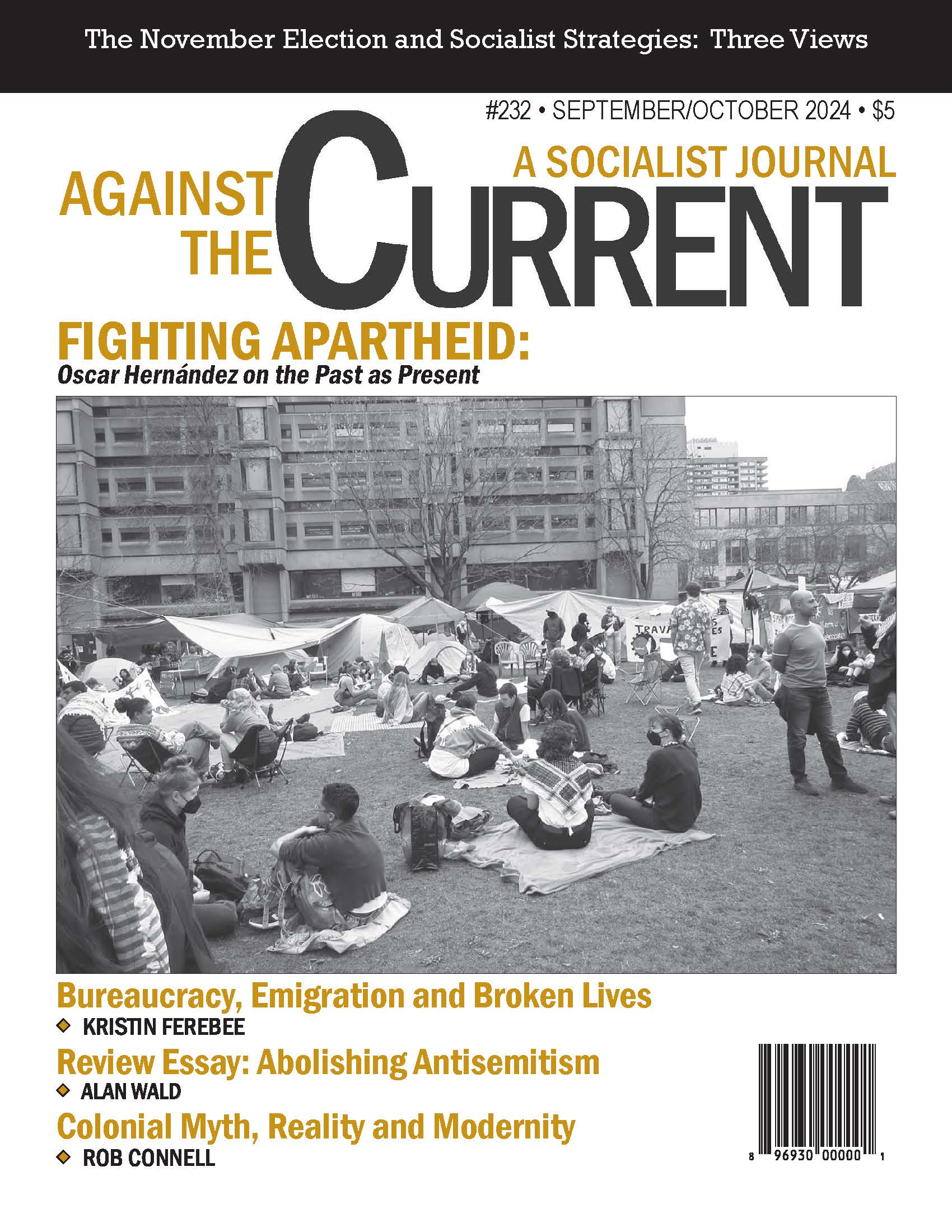Against the Current No. 232, September/October 2024
-
Slouching Toward November
— The Editors - On the 2024 Election: Three Views
-
Why Socialists Must Defeat Trump
— Dan La Botz -
Socialist Support of the Green Party
— Howie Hawkins -
What Question Are We Answering?
— Kit Wainer -
Sonya Massey Killed by Illinois Police
— Malik Miah -
India-Pakistan Crisis: The Indus Water Treaty
— Mohammad Ebad Athar & Mona Bhan -
Bureaucracy, Emigration & Broken Lives -- A Narrow Gate
— Kristin Ferebee -
"No Fist Is Big Enough to Hide the Sky": 100 Years of Amilcar Cabral
— B. Skanthakumar -
The Past Is Present
— Oscar Hernández - Review Essay
-
Cause at Heart: Socialists & the Abolition of Antisemitism
— Alan Wald - Essay on Lenin
-
Lenin's Perspective: What Exactly Does It Mean to Vote — Part 2
— August H. Nimtz - Reviews
-
Colonial Myth, Reality & Modernity
— Robert Connell -
Turning Left in the Heartland
— Lyle Fulks -
Universities Weaponized: The Case of Israel
— Michael Principe
Malik Miah

POLICE ONCE AGAIN show their true colors: shooting in the face and killing a 36-year-old Black mother, Sonya Massey, in her own home in Springfield, Illinois. On July 6 Massey called 911 for fear of an intruder, and became the victim.
A police videocam (released to the family 11 days later) from the other deputy on the scene showed when the two cops entered Massey’s home. Deputy Sheriff Sean Grayson, with a long record of abuse, fired shots that hit Massey in the face.
The savage nature of the killing was not revealed immediately. Typically, an internal police review occurs first, and the police officer is put on paid leave. Not this time.
The police union, as expected, filed a grievance protesting Grayson’s arrest and termination. However, under intense community pressure, the union later announced it would no longer challenge the charges.
The Timeline
News media from USA Today, CNN, The New York Times and Illinois papers including The State Journal-Register, gave a clear timeline of what happened hour-by-hour July 6 and afterwards:
Around 12:50 a.m., two Sangamon County Sheriff’s deputies, including Sean Grayson, were called to a home in the 2800 block of Hoover Avenue in an unincorporated part of Woodside Township for a possible intruder.
No intruder was found. Court documents filed by prosecutors said Massey appeared to be “calm, possibly unwell, and non-aggressive.” In fact, the footage shows Grayson and another deputy speaking calmly with Massey in her home — at which point she goes to the stove to turn off a pot of boiling water and the situation escalates.
Three shots are heard and after a few seconds of silence, one deputy said, “shots fired” and called for emergency medical services. The implication was that Massey shot first, even though she had no gun.
Massey was taken to the hospital where she died. The case was referred to the Illinois State Police Sheriff.
On July 8 an autopsy revealed that Massey had died from a gunshot wound to the face. Even before the Massey family saw the body camera footage on July 17 they hired national civil rights personal injury attorney Ben Crump and called for a probe into the hiring of sheriff’s deputy Grayson. He had worked at six different law enforcement agencies in four years, and was charged with driving under the influence twice.
Indictment and Protests
On July 12, a two-hour protest at Sangamon County Building demanded the release of body camera footage and transparency in the case. More protests took place on July 15-16.
On July 17 Massey family members reviewed the body camera footage and mentioned that Sonya had been diagnosed with paranoid schizophrenia. Later Massey’s father, James Wilburn, said he had initially received conflicting information from law enforcement:
“I was under the impression that a prowler had broken in and killed my baby. Never did they say that it was a deputy-involved shooting until my brother read it on the internet.”
As protest rallies continued, a Sangamon County grand jury indicted Grayson on five counts, including three charges of first-degree murder. He surrendered to the police and was later terminated by his department. At his July 18 court appearance Grayson plead not guilty to the charges and the judge denied his petition for release.
Protests continued. After about 200 supporters rallied at the Springfield NAACP Building, authorities announced that body camera footage would be released to the public on July 22.
“Crime Against Humanity”
On July 19 Massey’s funeral was held with Crump eulogizing Massey, predicting that the bodycam footage would “shock the conscience of America,” similar to images of Emmett Till, a teenager whose lynching in 1955 galvanized the Civil Rights Movement.
Nearly two weeks after Sonya Massey was murdered, Sangamon County finally released the body cam footage to the public as protesters marched in Massey’s memory.
Ben Crump announced that the U.S. Department of Justice opened an investigation into the case. Then DOJ held a community meeting where a panel of nine county officials, including the sheriff, led off with apologies. The audience of 500 demanded action, not mere words.
Both the governor and lieutenant governor met with the family, and Vice President Kamala Harris spoke with them and issued a statement calling the death “senseless.”
The fact that the state police and county moved quickly to fire and prosecute Grayson also shows the impact of the Black Lives Matters movement. Such a fast-moving response to a police officer killing a Black person is rare. It took the horror of a video to show the criminal police actions.
But unless the meetings and demonstrations continue, there will be no change.
July 28th National Day of Mourning rallies occurred in New York, Los Angeles, St. Louis and Washington DC, as well as in Illinois. Other communities held “Remembering Massey” vigils, including in Kansas City, Missouri; Cedar Rapids, Iowa; and Wilmington, North Carolina.
The Massey family, including her two teenage children, have been to as many as they can. They seek justice and desire to end the killings. Almost 1200 people shot to death by the police were in 2023, and each year the count is higher!
Abolish and Replace!
Tahir Duckett, a civil rights lawyer and activist and executive director of Georgetown Law’s Center for Innovations in Community Safety, noted in a July 24 essay for The New York Times the broader context of the killing and police “reforms”:
“The death of George Floyd in 2020 drew public outrage and calls for a wide variety of police reforms. There is still a lot we don’t know about the Massey situation, including if she was experiencing mental distress. But the killing of Ms. Massey is a cold reminder of how little has changed in the years since.”
Justice for victims of police violence and killings will require much more than reforms that have been stalled so far. Policing as it exists must be abolished and replaced.
September-October 2024, ATC 232

